


Like it? Share it!

I’m speaking on BBC Radio Sheffield about the increase of young children being excluded from school from as young as 5.
Recently I wrote about ‘School Readiness’ as this is a complex subject not easily dismissed by the taxi driver who said to me, ‘All they need is a good smack.’
Here is an article published in The Telegraph on a new Channel 4 documentary, Excluded at 7 which you can watch here
“Sharon Donaldson sighs as a boy thrashes at a door and screams. “Why are you so angry today?”
“F*** you,” he shouts back.
Sharon shrugs. She’s headteacher of Rosebery School, a short-stay school in Kings Lynn, Norfolk, for children who have been permanently excluded. The boy is Harvey. He has been excluded more than 15 times, the last just after his 7th birthday. He is new to Rosebery. Sharon’s seen it all before, and Harvey’s reaction isn’t uncommon.
His story isn’t uncommon either. Figures released last week by the Department for Education show that the number of permanent exclusions have increased in the last year. Some 6,685 children are permanently excluded from school every year – and just under 20% are under 12.
A new Channel 4 documentary, Excluded at 7, follows the school’s students, their behavioural problems, and the gargantuan task the teachers have in trying to correct these problems and make the children fit for school again.
The reasons the pupils – who are mostly boys – have been excluded from school vary from “I nearly broke a teacher’s back” to “I got the answer wrong and I started hitting everybody”, but they all involve violence to themselves, others or school property. Many involve all three. Sharon and her team work with no more than 14 children at any one time. They’re split into classes of seven, where their behaviour is closely monitored and each lesson is tailored to their needs. Many of the children who pass through Rosebery have autism or ADHD so the challenge is to get them to learn their times tables and spellings, as well as to curb their salty language, in the hope they will find a school willing to accept them permanently.
One of the major challenges, says Sharon, is the children’s emotional literacy. Getting them to explain how they feel about home and school is much more complicated than it is with other children, and it’s the first step towards getting them to learn. As we tour the two small classrooms, Sharon points out a girl who is terrified of going to senior school next year. By way of bonding during afternoon sessions, one of the female teachers has been showing her how to style her hair and paint her nails so she won’t feel so isolated at “big school”. During their sessions, the girl has opened up, and the teachers are able to tell her parents what’s bothering her.
At the other end of the age spectrum is a five-year-old boy with severe home problems who has been excluded. “He just can’t explain how he feels. It’s our job to unpick the pieces and put them back together in the right places,” says Sharon. “We do paintings with him, and on them we write how he’s feeling.” She shows me one – a big bird in purple and green. It says: “I would be happy all the time if I had no worries” and “I would like to be at school more.” It would take some hardness of heart not to feel a tug of sadness.
This is hardly the borstal that some might expect. The astonishing thing about Rosebery is how well-adjusted the pupils seem. As we walk around, a shy child comes and offer fairy cakes as an end-of-term treat, mindful of leaving one for their class teacher.
Teaching empathy and self-control is a core part of the children’s education. “We use reading sessions to chill them out sometimes when the class is misbehaving,” says Richard Edmonds, a 6ft 2in man of Churchillian stature who is often used in a kind of bouncer role when the children are out of control. What happens when they misbehave? “Sometimes someone has to leave the class, but we’re pretty good at spotting the signs.” Red lights include clenched fists, screwed up faces, or a general sense of momentum gathering. Some like to go outside to cool off, some need to sit in the corner, some on a bean bag.
Discussing every possible aspect of parenting, giving you advice and support on topics which affect your daily life. Each free, weekly episode is bursting with practical tips, techniques and ideas.
I will teach you my no-nonsense, simple techniques & give you hundreds of my expert parenting articles, videos & podcasts so you can get back to the business of having fun with your family!



